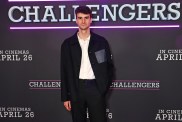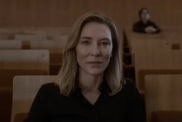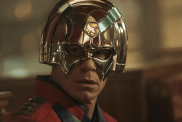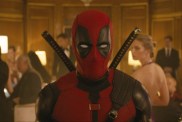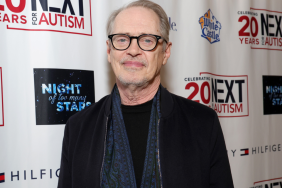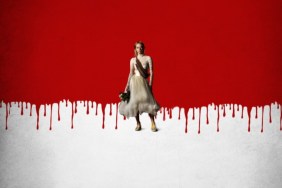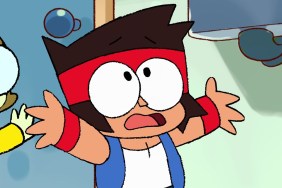The actors and crew interviewed

“When I first met Jon, the director, I warned him that I’m a bit performance masochist, and he said, Good, ’cause we are gonna kick your ass.” – Krysten Cummings.
How nervous and excited was I to squeeze in a set visit for ShockTillYouDrop.com in between my own night shoots on a low budget horror film? The answer: Crazy nervous. Crazy excited. So much so that I arrived 45-minutes early. The car park at Ealing studios was jam-packed and I left my car keys with a guard who I’d cast in a horror film any day. This being my cheeky second visit to the awesome cave sets of The Descent 2 – as a few weeks prior to the shoot I got a great tour from Simon Bowles the production designer, where I got to see a glimpse of the making of mines, signs and lift shafts – I marched my way to the production office to meet up with my tour guide and let them know I was here.
First impressions: Everyone was incredibly laid back; surprising since it was the third day from the end of shoot. My tour guide Georgia and I entered the studio through the hefty double doors and there I was. Ahead of me was a fantastic rock surface painted with horizontal, diagonal lines glittering under the beautiful light. The camera crew was just setting up a new shot and the art department was climbing about with water sprays. Shauna MacDonald (encoring as Sarah) and Krysten Cummings entered the set for final checks and props handed them their torches. Today was a water tank day, the girls were going to enter the caves and submerge into eight foot tanks of water.
I take a step back and watch the cast and crew get into position as Georgia introduces us to the second and third assistant directors so that we can steal interviews. There’s quiet for a rehearsal, and Jon Harris, the director talks through the scene with the girls. Then its red light and bell, as I lurk in the darkness and watch our hero Sarah slowly slide her way along the rock surface followed by Rios (Cummings). There’s water trickling down the cave. Judging by the dirty makeup on the girls, they’ve been down there for a while. They exchange some lines and slowly move along the cave. A camera moves in closer and they shoot some close-ups. Just then we see James Watkins the writer sneak past us, Georgia introduces us and we head for Juno’s dressing room (yes, Juno is back) for a quiet chat.
ShockTillYouDrop.com: So then James, how did The Descent 2 all start for you?
James Watkins: I made a film which is coming out in the summer which is called Eden Lake. Jon edited it and Christian [Colson] produced it. So it worked out that Jon edited my film and then I came in and wrote his, and Jon came in and shot my second unit and now I’ve come in and I’m shooting his second unit. I never knew Jon before, but we have become good friends and are helping each other out. I have a bit of a background in horror as I was one of the writers of My Little Eye a few years back and so Christian got me on board.
Shock: Did Neil Marshall have any input?
Watkins: Yes, every stage of it went to Neil and he gave us his notes. We would sit down and get his feedback and discuss which direction he wanted the story to go, what he thought was good, how we should develop the characters, discussions about Juno and all sorts of stuff like that.
Shock: How did you come around with the idea of Sarah coming back and putting her down in the caves again?
Watkins: One of the models that we always looked at was Halloween II, in terms of making a film which takes off from where the first one ended. I think even before I was involved there was a lot of discussion as to “What if you were to make a sequel to The Descent?” Where would it be? Would it be outside in the world? Would it be following Crawlers? Would it be backstory/pre-story? You could go anywhere with it. It seems like a lovely continuation of the story of saying, a group of girls have gone down a hole, and they’ve gone missing. Someone’s going to notice they’ve gone missing, so in the real world there’s going to be a rescue team sent after them. Then of course who rescues the rescuers? How does that work? So you get this anticipation as you know – well the people who saw the first film – what they are going into. Then what you get with the rescue thing is another group dynamic, a new set of people to interact with, and then you have to bring in some men. To have it all with women again it would have been all too contrived. So that was a new element to bring in and to follow the story through, which seemed like a natural progression really.
Shock: Have you written in some more gory deaths into the film?
Watkins: I honestly feel that this film is going to be more violent that the first. I got a skewed sense of things as I’m shooting second unit, I’m shooting all the close-up gore with Paul Hyett’s prosthetics. He is a legend, he did my film Eden Lake, he does all Neil’s films. So I’ve been doing close-ups of prosthetics. Crawlers’ heads and somebody getting out a drill and drilling them. For us you have all that fun stuff, but at the same time what I felt was good about the first film was the way in which Neil tapped into the real deep horrors of claustrophobia, abandonment, fear of the dark, the terrifying sequence for me was when Sarah gets stuck and she has her panic attack. For me that’s much scarier than any monster stuff. The sequence that Jon and I came up with to top that is to do it with water. Jon and I went on a little trip to Yorkshire and went down a cave with some cave rescue guys and we didn’t get very deep at all. It’s pretty dangerous. The real extreme cavers do the water stuff. Going into the water not knowing where you’re going to come out, I wouldn’t even want to do that on the fantastic set Simon has built. For me this is a stand out moment in the film, tapping into really deep primal fears. Gore is pretty straight forward and pretty simple. I think with a really strong horror movie you have to get into the core, it’s much more powerful. You have to put gore in there, to give moments for people to cheer about – and there’s a ton of that – but if it was just that then it’s not enough.

James and I chatted some more about elements of gore in his film Eden Lake and discussed the great feeling of working with crew that have already gelled and become that little film family of support. We wrapped our interview and I let James get on as later he was shooting some second unit in the caves. Georgia and I ventured off back towards the set and we spot production designer Simon Bowles at another stage which was being pulled down as shooting of the set had been wrapped. So, we steal him for an interview heading to his office, whilst passing a member of the art department carrying a huge box of bones.
On my first visit to the set I was taken around the mines as they were being painted. They were intricate tunnels with shafts that gave me that feeling of being in some sort of spooky horror tour, where you have to climb around corners and drops to survive not knowing what’s around. While watching this process I got to see the layers of how it’s made up: A wire mesh supported with a wooden and scaffold structure, a brown crinkled paper over the mesh and then huge oil drum tanks of spray foam is sprayed onto the paper, creating the rock surface. It’s then painted with a mixture of emulsions and water. I also learned that some rock surfaces were casts of real rocks adding to the fantastic realism.
Being that my first interest in horror filmmaking is within the art department, getting to see how the big boys work compared to my attempts is always an eye opener. As you enter the art department you are greeted by a shelf of models depicting the great cave sets. Simon’s office is filled with research pictures of caves and location shots. I was quite interested as to what new challenges Simon had made himself in regards to the new awesome caves as after three years there is sure going to be the combination of knowing what does and doesn’t work and how to make the second film more exciting.
Shock: So Simon how’s it all been?
Simon Bowles: Really good and very exciting, its been three years since the first one and we are all good friends, Sam and Jon, [1st A.D.] Jack and Neil, so over the last three years we have been talking about ideas for the sequel, even when we came to the end of the first film we joked about, “What if there was a next one?” It’s been exciting looking for ways of making it different, more fantastical, moving it ahead and thinking more about how the Crawlers use the space. A big thing is that we changed the way the characters enter the cave as before they went straight into the cave system. Whereas on this one we are going in through an old mine, which has these tales of men going missing, which is great as we know why. So we have this rescue team going into this old mine, which has been closed for 80 odd years, so they’re all falling apart and leaning, the railway track that runs along the floors all twisted and broken which is really cool, then they enter a space which is all boarded up and that’s how they enter, they pull apart the boards and go through. These aren’t the same caves as of the first film, there is one cave from the original film which is from a scene where Sam had died and was hanging down all bloody with her guts out.’
Shock: Has it been more relaxing as you have been here before?
Bowles: Yeah it has, but the problem with that is that we now push ourselves further and the sets are more complex than what they were the first time around when we did just big bold shapes and used space whereas this one has a lot more searching and crawlers hiding and jumping out. On the first one there wasn’t really that much location work , on this one the first fifteen, twenty minutes is a lot of location work. We have a rescue team set up with police cars, a big rescue hummer that I got to design, which was very cool. We shot that at [the popular London film location] Borehamwood which was cool as in the first one we shot most of it in Scotland. And we have the same kind of budget for this so if we could simplify it then we did to keep all the money on screen. We shot in forests and locations in and around London. We had this big base and then we built the bottom half of this wheel house. The old mine, we built the bottom thirteen foot of that, with a CGI extension. Then we took that set and turned it inside out and brought it to the studio and built the interior of that building with the same scenery. We had to build a practical lift, with a rolling wall. I’ve been trying to build this rolling wall for the last two films and tried to do it on Doomsday. On this one I actually got it and it works really well. Making all that hands-on stuff and actually making it real is better for everybody. I could have had a greenscreen behind the lift car, which is fine, but to actually have a real rock face going past on a loop with lights bolted to it…the shadow of the grill goes up past [the actors’] faces, which is great for the actors and I try and design as much as possible for the actors. I try to make it very easy for the film crew to film so there are nice flat areas for the camera, but then [I make it] very difficult for the actors to get from one side of the set to the other. There’s nothing better than seeing them try and work out where to put their feet and still be in the realms of safety. To not have a completely flat floor to have them holding on to bits of rock is much more realistic. Early on we did lots of reference and on the first film I went down to Cheddar and Wooky Hole with some of my construction guys and sculptors. We took loads of photographs and talked loads about seeing all these weird constructions that all this calcium makes, we took lots of ideas from those visits. We also went down and did proper pot holing, and I asked the cave guy to really get me stuck, he actually got me really stuck in a hole and I just couldn’t stop laughing, which was difficult as I couldn’t properly breathe out. Then to also go into a big cave and to switch off all the lights in the group, you just could not see anything. You really understand you are a quarter of a mile under rock, it’s so heavy and it makes you feel really tiny. There were really good lessons to learn while designing the sets. Making the people look tiny in huge spaces and big in small spaces.

While we talked about methods of getting through tunnels and small rock surfaces Georgia mentions a Crawlers pit set. I then learn that there are a couple of new ones which sound pretty horrible. One of which has been nicknamed a “Poo Set,” where the Crawlers seem to have been clearing those rotten bowels, and the other of which I feel pretty gutted to have missed is the “Crawler Feeder Chamber.” Bowles explains…
Bowles: This is basically the final big set up of the whole film. They climb up over this lip and then see a crawler dragging in a dead deer which has had its throat ripped out, this is where the Crawlers bring in their food, there’s bones and blood every where. I designed it so that it looks like a massive ribcage, so you’d have to climb from one end then to the neck end. There was the bones pit on the first film, where they were all clean white bones, in this one they are very much fleshy and bloody. The first cave in this film is pretty much your standard cave. It’s beautiful. There’s water and stalagmites. You take this journey all the way through the film and then at the end we got the opportunity to really push the boat out, so it’s going to be black, its going to be covered in blood, then it looks like a ribcage. It’s great and we have shot it in order so I can pace myself as we go. Every time we build a new set or re-vamp one, the painters say, “What color you want it?” and as we know where we are in the film I can pace the way we do color schemes.
As you can probably tell I could have stayed and hung out with Simon all day. I got distracted by his original sketches of rock surfaces and the designs of cool American-looking police cars. Georgia pointed out that we should see if we can head back to the studio to get ahold of the girls for a brief chat in their busy schedule. We said good-bye to Simon and off we went, back to the caves. The second A.D. bumps on us and says that as they are breaking for lunch and moving onto a new cave set up – the one with the eight foot tank of water – so we could get the girls for a brief chat before lunch. I was introduced to Shauna and Krysten, still in their make-up and we headed over back over to Juno’s dressing room.
Shauna, who plays Sarah, we are familiar with and now also have the talents of newbie Krysten Cummings who comes from a theatrical background where she is famous for her part in the hit Rent. Krysten is playing a new character called Rios.
Shock: How’s the shoot going?
Shauna MacDonald: Really good so far. It’s the last week, it’s hard. For me there’s more fights, it’s more physical than last time, but also I’m staying in Ealing so I just have a short walk into work whereas you have about an hour and a half’.
Krysten Cummings: Yeah, I come from Hackney. No matter what time in the morning I leave it takes ages.
MacDonald: It’s just been packing the hours in. And we were doing six-day weeks for a while, but you know it’s great. Your life outside kind of goes on hold.
Shock: What’s been the biggest challenge so far in regards to the film?
MacDonald: Well, like I said it’s a lot more physically demanding. The last one was, too, but I think in this I have three big fights, but it was demanding for me just to get her emotional journey as you’d think she’d never ever go back in that cave ever. Trying to make that truthful was tricky, trying to play out what she does remember, what she doesn’t remember. We want her to ascend not descend, but you have to get her back in the cave otherwise there’s no film, and you have to try and make it believable or the fans will not be like you.
Shock: Shauna what were your first impressions when you were told about the sequel?
MacDonald: I was at an awards ceremony and it was mentioned that they thought about making a sequel. I thought it was a terrible idea, then I had a bit of time to get my head around it. I realized that there was another story that could be told. If you just open your mind, when you finish a film you feel that it’s a self-contained story. So as I started to communicate with Chris, the producer, and Jon, I realized the story and the emotional journey of Sarah and the other characters. But I was concentrating on Sarah, and I was very excited about it.
Shock: How has it been filming the sequel but with a different director?
MacDonald: Well, Jon was really around, post-filming of The Descent, so I have known him for almost as long as I’ve known Neil. It wasn’t that odd, it’s just with a different context. He’s not editing he’s directing. I always try and open up as quickly as I can with directors. As soon as you can communicate your life is going to be so much better on set. With Jon you don’t really have to make so much of an effort as he’s so lovely, he just talks through everything. He’s open to your ideas and just brilliant and super smart, which makes things a lot easier.

Cummings: He’s really relaxed as a director.
Shock: How has this shoot been for you Krysten?
Cummings: Dysfunctional. [laughs] There are a lot of people that worked on the first film. It’s been an amazing trip. This is my first film, my first any film. I’m having trial by fire. I joked with Jon when I first met him that I’m a bit of a performance masochist, and he said, “Good, ’cause we are gonna kick your ass.” It’s been really good fun, I’m a bit sad that it’s in the last days.
MacDonald: We’ve bonded, but like in a real way, not a cheesy way. It’s been an amazing experience for both of us. This is Krysten’s first film, and my coming back with a lot to lose as the first film went really well and my life had moved on so much. Then I thought, “Oh no, new people, f**k,” but then it’s been f***king brilliant.
Shock: How do you feel about some of the criticism that has already been on the websites about this film?
Shauna: I think its good, as it makes you work really hard to make new layered, believable, fully-formed characters. I’m glad that we are faced with cynicism and skepticism as it makes you pull your finger out and you want to make it bigger and better than the first. No one knows the storyline so I know it’s a strong story as a sequel. They are keeping it quite quiet, there was so much stuff unresolved at the end of the last one.
I let the girls get off to lunch. Shauna had her lovely little girl around to entertain us with big smiles in the canteen queue. Heading back to set I saw Sam McCurdy, the director of photography, smoking a rather huge cigar which I thought was pretty cool. We decided that we’d go and pay producer Christian Colson a visit up in the office. We went into Jon’s office, which had cast photos around the walls and settled down to the sounds of a noisy construction team outside.
Shock: So, Christian, how has the making of The Descent 2 been for you?
Colson: This has been a lot less stress and fun. I will feel totally relaxed when it’s finished shooting. There are many things that go wrong: Someone could twist an ankle, there’s water involved, hanging. It takes 40 days to make this and if you only have half a film it’s no good to anybody, it’s no good until it’s done. It’s all gone really well, plus we know everybody from doing this before. It makes a huge difference, in process and prep, really. You’ve got all these huge challenges: How are we going to build these caves? What are these creatures going to look like? Who are we going to cast? Who is going to shoot it? Who’s going to cut it? You have all these decisions to make, which are unknowns, but in this case we knew Sam was going to shoot it, we knew Simon was going to design it, we already know what the Crawlers look like. We know who is playing Sarah, we know exactly where her character is at the first movie. You’re starting from this base where a lot of these conceptual design challenges are not there. Which is incredibly liberating as you can focus on telling the story. It’s a really nice thing to do, as a lot of the scary unknowns aren’t there, its more pure. There’s a great atmosphere down there, considering they’ve been in the dark for weeks. It’s pretty much the same crew, they’re all friends. Jon has been absolutely fabulous, that was the key break through, figuring out that Jon was the guy to do it. Editors are filmmakers, they’re storytellers. Jon has the filmmaking skills and knowledge. He is also used to watching raw material coming in. He’ll watch it on a monitor, element by element, then he’ll put it together and you can see when he’s out there shooting, he is interested in what is going to be on the monitor. It’s a very practical way of directing as what you have to figure out is, “What do I want to see?” and he puts it in there. Whether it’s a script, or a change of performance or a composition of the shot, whatever it may be. He has been absolutely great and will go on to do other things directing. ‘
Shock: What elements needed to come together to make this film happen?
Colson: With the first film we had such a great time. It was a case of, “If you’re going to do it then let’s continue Sarah’s story.” That was an emotional spine from the first one, it was really Neil that said, “Let’s get the same team together and if we can’t then lets not bother.” That seemed to be a good thing to aim for and that’s what we did. If we can get a cracking script, then Shauna wants to do it and Neil’s behind it. We got all the team back then we got a chance of making it better, which is what you have to aim for. There are loads of unheralded guys in this film. For instance, the importance of sound in this film, those sets and what Simon does with those sets are amazing, they look incredible. Simon was really under-credited on the first film as people thought we shot on location. They look amazing but they don’t sound it as they are made of foam resin. When our sound guys came on board they went off caving and recording. What does a hard hat sound like when it’s scraped along a rock? What does a foot pool sound like deep underground? They went and shot all that sound, and when we first heard it layered in with the film we were amazed. We have these guys back again too. There’s a high level of detail and passion of talent in this film, you know you’re in safe hands with everybody.

What fantastic words from Christian. He is really proud of this project, much like everybody is. We left Christian to bite his nails for the final three days and headed back to set.
There we found the new water tank set-up. A diving guy was on standby in a wet suit and the special effects techs were adding some more water. The urge to jump in the tank was pretty compelling and I discovered the boom operator had wishes to get in there too. I also had an urge to start picking up stray bits of debris on the floor and start set fluffing or volunteer to help catch some stray poly, as being on set and not apart of the creative team for such a great film was killing me.
This set-up was a pretty massive cave and there was an “A” and “B” camera on the girls. Jon discussed shots and the guys and gals all got into place leading up to going under water. The art department got out their water sprayers again and collected up stray bits of foam rock floating about. I managed to steal a look at takes on the monitor. All of the lighting made the water and the caves look so realistic. Sam McCurdy is an awesome director of photography. It was time for the girls to get into the water tank. The diver got onto the side they were going to come out of and we all gathered around. Shauna was the first in, and then Krysten. These were one takes as to dry and re-set would be too long. I overheard a makeup girl being pleased that the makeup had stayed on in the water and while the girls were dried off. I noticed the art department was pulling out a section of the set, this was to be the tunnel that the girls come through after the water. I was really impressed with the cleverness of the design re-using the space for the sets.
There was a break for tea as there was to be some more blocking for the next scenes. This was when we decided that we should shoot off. I felt pretty pleased with what information I had from The Descent 2. I had an education on filmmaking I probably would never get from a book or course. Everyone I spoke to was really down to earth and enthusiastic about this project. I had the impression that the shoot had run pretty smoothly and there was a sense of pride amongst the cast and crew, considering the crew was smaller than what the first film had. They are now so much more experienced and capable of making something bigger and better, I have no doubt in my mind that this film is going to be another great UK horror film. Is it going to be better than the last one? I hope so, it sure as hell sounds that way to me so far. Be prepared for more claustrophobia and creepy crawler cave action!
Keep your eyes peeled for interviews with Director Jon Harris fresh from the cutting room and FX man Paul Hyett.
Source: Misartress Melanie

